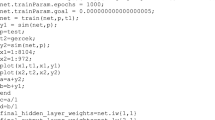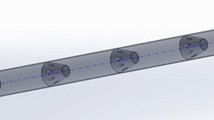Abstract
Application of radial basis neural networks (RBNN) for prediction of cavitation vortex dynamics in a Francis turbine draft tube is presented. The dynamics of the cavitation vortex was established by fluctuations of a void fraction in a selected region of the draft tube. The void fraction was determined by image acquisition and analysis. Pressure in the draft tube and images of the cavitation vortex were acquired simultaneously for the experiment. RBNN were used for prediction. The void fraction in the selected region of the cavitation vortex was predicted on the basis of experimentally provided pressure data. The learning set consisted of pressure – void fraction pairs. The prediction consisted in providing only the pressure. Regression coefficients r between the predicted and measured void fractions were in an interval of 0.82–0.98. A good agreement between power spectra and correlation functions of measured and predicted void fractions was shown.








Similar content being viewed by others
Explore related subjects
Discover the latest articles and news from researchers in related subjects, suggested using machine learning.Abbreviations
- A :
-
Void fraction
- E :
-
Pixel intensity
- f :
-
Function
- f p :
-
Frequency of the acquired pressure
- g :
-
Gaussian function
- j :
-
Length of the time-delayed input vector
- k :
-
Index
- K :
-
Number of neurons
- l :
-
Pixel coordinate
- m :
-
Pixel coordinate, weights of neurons
- n :
-
Index
- N :
-
Number of experimental samples
- p :
-
Pressure
- q :
-
Center of the receptive field of neurons
- r :
-
Regression coefficient
- t :
-
Time
- x :
-
Input, time-delayed pressure pulsations vector
- y :
-
Void fraction output
- σ:
-
Width of the receptive field of neurons
- ANN:
-
Artificial neural network
- CPU:
-
Central processor unit
- RBNN:
-
Radial basis neural networks
References
Fanelli M (1999) The Cavitated « Vortex Rope » in the draft tube of francis turbines operating at partial load: a transition from turbulent ≫Chaos≪ to Order? In: 9th international meeting of the IAHR Work Group on the behaviour of hydraulic machinery under steady oscillatory conditions, Brno: A1
Brekke H (1999) A review on dynamic problems in Francis turbines. In: 9th international meeting of the IAHR Work Group on the behaviour of hydraulic machinery under steady oscillatory conditions, Brno: A2
Blommaert G, Prenat JE, Avellan F, Boyer A (1999) Active control of Francis turbine operation stability. In: Proceedings of the 3rd ASME/JSME joint fluid engineering conference, San Francisco. FEDSM-7210, pp 1–8
Pedrizzetti G (1995) A three-dimensional computational approach to the vortex rope dynamics in Francis turbine outlet. In: 7th international meeting of the IAHR Work Group on the behaviour of hydraulic machinery under steady oscillatory conditions, Ljubljana: B1
Uchiyama T (1998) Numerical simulation of cavitating flow using the upstream finite element method. Appl Math Model 22:235–250
Grabec I, Sachse W (1997) Synergetics of measurement, prediction and control. Springer, Berlin Heidelberg New York
Hsieh CC, Wang SB, Pan C (1997) Dynamic visualization of two-phase flow patterns in a natural circulation loop. Int J Multiphas Flow 23:1147–1169
Gopalan S, Katz J (2000) Flow structure and modeling issues in the closure region of attached cavitation. Phys Fluids 12:895–911
Gad-el-Hak M, Pollard A, Bonnet JP (1998) Flow control: fundamentals and practices. Springer-Verlag, Berlin Heidelberg New York
Orr M (1999) Matlab functions for radial basis function networks. http://www.anc.ed.ac.uk/~mjo/software/rbf2.zip
Author information
Authors and Affiliations
Corresponding author
Rights and permissions
About this article
Cite this article
Hočevar, M., Širok, B. & Blagojevič, B. Prediction of cavitation vortex dynamics in the draft tube of a francis turbine using radial basis neural networks. Neural Comput & Applic 14, 229–234 (2005). https://doi.org/10.1007/s00521-004-0458-4
Received:
Accepted:
Published:
Issue Date:
DOI: https://doi.org/10.1007/s00521-004-0458-4




